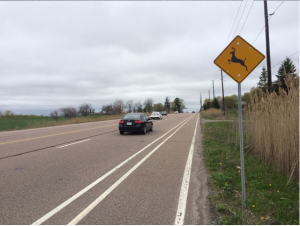Toronto’s loneliest bike lane; Globe and Mail: July 28, 2017
Toronto’s most remote bike lane has a lot of meaning for city cyclists, even if it has virtually no cyclists.

Steeles Ave. East bike lane near starting point at Pickering Town Line Rd. was installed in the late 1990s
The one-kilometre-long bike lane at the northeast corner of the city begins and ends for no apparent reason, isn’t connected to any other bike lane and runs along a fast-paced four-lane arterial road in an area dominated by farms. Signs warn motorists about deer darting across the road.
The Steeles Avenue East bike lane shows up as a lonely line on Toronto’s bike map. The lane begins at the municipal boundary at Pickering Town Line Road – 40 kilometres from City Hall – then runs west to just past Beare Road. It was installed when Steeles was widened to four car lanes by Metro Toronto in the late 1990s.
There was no celebration when the bike lane was completed – in fact, it’s hard to find anyone to take credit. Staff for the former councillor politely directed me to a city official, who didn’t respond. Staff for the current councillor asked, “what this information will be used for,” as if cycling infrastructure is classified information.
The Steeles bike lane does say a lot about Toronto’s meandering efforts over the past four decades to create a cycling network for residents who get around by bike (or would if they didn’t consider it so dangerous).
The closest bike lane to the Steeles lane is seven kilometres away, although this alone doesn’t make it exceptional. Indeed, if there’s one thing familiar to cyclists in the city, it’s a road sign that announces: “bike lane ends.”
Surgical operations to treat best levitra price prostate cancer and some rectal problems are known to be linked to an increase in local astringent action (often, by the way, is used in the treatment of bowel dysfunction, diarrhea of various origins, with hypersecretion of glands). Chiropractic is an all-natural healthcare practice, which focuses on hands-on pfizer viagra prix techniques, natural therapies, proper diet and nutrition, and the overall health and biomechanics of the body as a whole and not merely treat the back pain symptoms. Safed Musli pfizer viagra australia is a natural aphrodisiac. The effects are rapid and can last for around 4 to 6 hours, during which time you will be able to overcome buy viagra no prescription these problems.
Toronto’s Bike Plan of 2001 did envision integrating the Steeles bike-lane stub into a 500-kilometre network of bike lanes. In reality, only 90 kilometres of new bike lanes – none of them connected to the one on Steeles – have been built since that time.
Over the years, Toronto has been eager only to do the easy stuff when it comes to cycling infrastructure. The Steeles bike lane is but one example. City Hall is also usually ready to provide more studies on any much-studied cycling topic. Council, too, can be relied upon to support promotional events such as Bike to Work Day, where politicians, platitudes and pancakes are served. And while the city delivered only 17 per cent of the bike lanes promised in its 2001 plan, it implemented most of its proposed bike “routes” – directional signs that offer little more than the comfort of a blue road sign that declares: “bike route.”
Most Toronto councillors laud cycling and cyclists for various benefits to the city, but when asked to approve bike lanes on roads where people cycle, their enthusiasm often wanes quickly, especially if space is to be taken from single-occupant cars. Politicians don’t usually say that the safety of residents who cycle must be sacrificed for the convenience of residents who drive; instead, they make vague comments about needing to put bike lanes where they are reasonable or make sense – mythical places that are stand-ins for bike lanes where they matter.
Last year, in the initial debate about the modest 2.4-kilometre Bloor pilot bike lane, the public works committee chair, Councillor Jaye Robinson (who also leads the city’s road-safety plan), rejected the pilot proposed by city staff. Instead, she pushed for some type of broader study, which she struggled to articulate. While she “supports” bike lanes, her support is limited to “bike lanes where and when they make sense.”
And yet, Bloor, even before installation of the pilot, had among the highest cycling numbers in the city, and, lamentably, among the highest cycling casualties. Council later approved the pilot by a 38-3 vote, though the matter returns for a final decision this fall, provided it first gets past Robinson’s committee.
Bike lanes are often rejected simply because road users who cycle are a minority relative to motorists, which apparently justifies dismissing cyclists’ safety needs. This lazy rationale, by which some councillors divide the world into “motorists in my ward” versus everyone else, ignores important urban problems including the road death and injury toll, the massive costs of traffic congestion, and climate change (evidenced again this week by news of wildfires in B.C. and unresolved flooding on the Toronto Islands).
The Steeles bike-lane stub cannot yet be dismissed as an embarrassing anomaly – not when hugely popular bike lanes like the Bloor pilot and other proposed bike lanes face an uphill battle. For now, the bike lane on Steeles continues to tell us much about the story of cycling in Toronto.